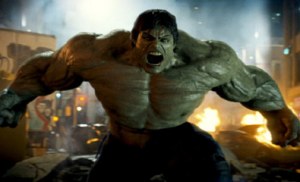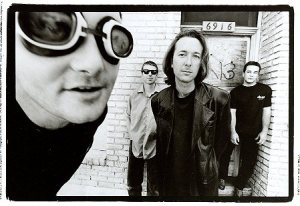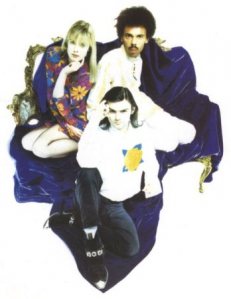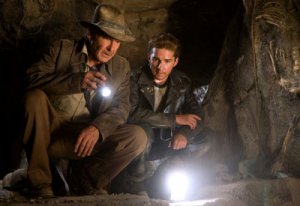Thursday, June 12th, 2008
•
Horrorthon Posts

[I originally posted this as a comment below, but nobody’s replied yet (in a whole half-hour), so I’m impatiently clamoring for readers by re-posting it up here. Pay attention to me! Me, me, me, me!]
[UPDATED BELOW]
You know, the thing about The Hulk story in all its incarnations is very simple…so simple that I’m ashamed that it’s taken me so long to figure it out. Here’s the problem: you’ve got this guy, right, who’s the main character; he’s running around from town to town dealing with his weird life, and then he gets angry or whatever and the alter ego is unleashed…and it’s somebody else.
Whether it’s Lou Ferrigno or a bunch of CGI or whatever, it’s just a different character and there’s just no way to reconcile the two entities into a single protagonist. The ‘seventies TV show is basically a drama about “David” Banner and his life dealing with small problems in the towns where he works as a short-order cook or whatever, not really dealing with his Hulk persona, and then Ferrigno comes in during a couple of mute sequences as a deus ex machina to solve everything. But you never feel like it’s him doing anything; it’s like the Hulk is some kind of remote-control guardian angel or something.
In a horror story like American Werewolf in London, this bifurcation and distancing is the whole point of the story. The werewolf isn’t David Kessler; he hates and fears it, and, in the few moments when the werewolf might behave like him (like at the very end) it doesn’t, and the horror is magnified. Vampire/zombie stories are the same: you can’t trust the protagonist once he/she is “taken over.”
But the Hulk is supposed to somehow be the “hero” even though he/it is really just a werewolf identity. He’s/it’s so scary and powerful and Banner hates him/it (and wants an antidote as desperately as David Kessler would, if it were possible), but, when he becomes the Hulk, suddenly we’re supposed to accept the Hulk not just as “the hero” but as him, as the same person, which is ridiculous because the Hulk doesn’t have a fucking brain; he’s vaguely “attached” to a couple of people, King Kong/Fay Wray style, but basically he’s just a big fighting machine. Does Banner even remember what “he” did as the Hulk? (David Kessler has no idea what he did as a werewolf.) The TV show never makes it clear.
CGI exacerbates all of these problems, because while Lou Ferrigno was an actual actor, and therefore recognizable as a “person” (albeit a different person as I’m saying) the CGI Hulk has the added burden of being an animated character. It’s like the animated Kim Basinger in Cool World (which worked, sort of, because it was the same persona and the same voice). Banner runs around dealing with the plot and then he just exits the movie so a big special effect can sub in.
When Andy Serkis turned into the animated Gollum (at the beginning of Return of the King) it worked perfectly, because a lot of people were working really hard to connect the two personae into a single character. With the Hulk, as I’m saying, it’s a far more tenuous connection.
I’m not sure why it “works” in comic books. But then, I’ve never liked Hulk comics anyway. So what do I know.
UPDATE: Thinking back to the old comic book Hulk (from the Jack Kirby era) I remember that the Hulk had a lot of dialogue. He had a personality; it was very limited and child-like, and mostly based around his temper and ego (he threw big raging tantrums all the time, especially when the military was trying to subdue him, like all good monsters) but you could definitely get a sense of the Hulk’s feelings and motivations. They weren’t the same as Banner’s (in fact, if I remember correctly, the Hulk was aware of, and contemptuous of, Banner) but they were definitely part of the story.
None of this made it onto the television screen, for simple reasons; Lou Ferrigno couldn’t talk, so they had to re-shape the character as a kind of mute, mysterious “save the day” plot device as I said above. (Of course Ferrigno could talk but his speech was impaired and wouldn’t come across properly in the story.) Without language, you can’t figure out what the hell the Hulk is doing or why he’s doing it, so he becomes an extension of Banner’s id, destroying the train tracks of the evil corporation or whatever. The movies seem to have picked up on this approach, maybe because a talking Hulk is too corny for today’s tastes. But it leaves them with the same problem: if he’s not Banner, and he’s not his own character, then what is he? A special effect.
Monday, June 9th, 2008
•
Horrorthon Posts
My anxiety in this case is that my taste is so shallow that I’m just posting tracks that everyone else on Horrorthon not only has heard before but considers to be the most mainstream, freshman year “get over it” obvious music they’ve ever heard. I spent some time poring over my iTunes library but in the end I decided to go with my first instincts.
Primitive Radio Gods
“Standing Outside A Broken Phone Booth With Money In My Hand”

I still remember the first time I heard this, in the back seat of a Honda Accord on a rainy day, stopped along a country road beside a fruit and vegetable stand with the radio going and the driver out buying a bag of apples. 1996; not a particularly good time in my life, and the flattened out, hallucinogenic melancholia of this track made it stick in my head like chewing gum; apparently I’m not the only one who experienced this effect. When Napster first appeared (years before iTunes and legal mp3 downloads) and I had my first computer that could actually burn real music CDs (!!!) this was the very first track on the very first mix disc I made.
Dream Academy
“Life in a Northern Town”

From my college years, which was a strange time for music, mostly bad, when a lot of video-based innovation led to the popularity of a lot of questionable material, but (like most people my age) I can’t see past the nostalgia factor and I become like a grandparent grooving on some unspeakable big band crap as if it’s any good. Actually, the eighties were a time of major failure in all the arts except music, it could be argued: I like to say that everyone did their worst work in the eighties (Garry Trudeau, Stephen King, Woody Allen, everyone) but it’s not really true. Like television after Twin Peaks, the immediate post-MTV era encouraged a vibe of experimentation and cultural schizophenia very different from the crisply-defined guitar-rock and superband and new-wave that immediately preceded that time, and (if you overlook the preponderance of strange haircuts, mopey brits, and shamelessly bad synth) you can find some real gems, like this.
Sunday, June 8th, 2008
•
Horrorthon Posts

[NO SPOILERS]
Once upon a time, George Lucas and Steven Spielberg were on exactly the same page, and it was glorious. That time was roughly 1973-1983, and their careers were nearly mirror images: two film-school brats from the California suburbs who had each made intriguing debut features (THX-1138, The Sugarland Express) and extremely profitable follow-ups (American Graffitti, Jaws) before plunging into the sci-fi world (Star Wars, Close Encounters of the Third Kind). Spielberg hit the golden jackpot first, in 1975 (movie about sharks; top-grossing movie of all time to date) and Lucas took a couple of years longer (movie about space; top grossing movie of all time to date); along with his older, pig-faced mentor Coppola (movie about gangsters; top grossing movie of all time to date) they were the leading lights of the Hollywood Renaissance of the 1970s. So it was a Marx/Engels, Lennon/McCartney –level marriage when they joined forces to create an adventure movie called Raiders of the Lost Ark. It was their victory lap; a fused amalgamation of talent and enthusiasm that represented the summation of what they both believed about movies: they threw in everything they liked (ILM, John Williams, Harrison Ford) and everything they had “always wanted to do:” a James-Bond-style disconnected opening; a plot that was all “good parts;” a serial-adventure story like the pulp they’d grown up watching, with animated maps and treasure and chases and fistfights and cheeseball matte paintings and a spunky heroine (“I’m your goddamned partner!”) and Nazis and snakes and bugs and mumbo-jumbo and melting villain faces and a big room full of crates, Citizen Kane style, for the finale. They put all that into their movie and added their own unique genius for turning straw into gold and trash into sublime art, and, with seven trumpet notes and the crack of a bullwhip, a legend was born.
Thirty years later, the world is different and movies are different, but what’s interesting is that Raiders, as pure an expression of boyhood movie nostalgia as could be imagined, is now old enough to be a vital part of our nostalgic past. The troika of creators behind the fedora and the whip are now gray-haired senior citizens, themselves, and their original memory-piece is as much a part of cinema legend as the Saturday Matinees they were all lovingly mimicking, back when they were young men. But what’s especially fascinating is how much these two filmmakers have diverged, moved in opposite directions, in the years between; it’s a great cautionary tale, an applicable lesson that can be useful to anyone who’s working in the arts. After Star Wars, Lucas stopped directing. He didn’t want to do it any more; it was too much trouble. He handed his Star Wars sequels over to other directors and became a producer, exclusively. And then he vanished from the scene, working on improving ILM and developing Skywalker Sound and THX and the early versions of Pixar, basically disappearing into the wings of the cinema world. Spielberg kept directing, because he loved it and because he was so unbelievably successful at it, but, like Lucas, he also showed signs of fatigue. Three times, he tried to get out of the box he was in as “the world’s most popular director” who had focused his energies on kiddie fare, popcorn movies, American tales of windswept suburbia and friendly aliens and happy endings. While Lucas got out of the kitchen, Spielberg tried to change the recipe. First, he got the rights to Alice Walker’s The Color Purple and filmed it. Everyone scoffed, because how the hell could Steven “E. T.” Spielberg possibly do it justice? (It’s the only Spielberg movie not to have a John Williams score; he got Quincy Jones to do the music, for obvious reasons.) Purple was nominated for Best Picture but not Best Director; it was an obvious snub and it obviously bothered him. A few years later (while Lucas was turning his attention to television) Spielberg tackled J. G. Ballard’s novel Empire of the Sun, working with John Malkovitch and playwright Tom Stoppard and a young Christian Bale (in his film debut) and making a movie that’s breathtaking in its scope and power and visual genius…and got no respect. It must have burned him because his next two movies (Always; Hook) are the worst he’s ever made. But then something amazing happened: after an energizing return to form (Jurassic Park) he finally got his third at-bat—and finally swung for the bleachers and hit his home run, Schindler’s List, an unbelievable personal breakthrough that, I think, succeeded in carrying him into full-fledged creative maturity simply because it forced him to tap into his own darkness, his own anger and fury (as a sometime-repressed American Jew) and unleash the full force of his creativity. Everything since then (the entire Spielberg-Kaminski project, I call it, referring to the Polish cinematographer he’s made every subsequent movie with) has been genius, in my opinion. (Okay, maybe not The Lost World Jurassic Park or The Terminal, but still: Amistad, Saving Private Ryan, AI, Catch Me If You Can, Minority Report, War of the Worlds and Munich have a scope and range and maturity that rivals Hitchcock or David Lean or Kubrick). I used to ask, “Wouldn’t it be great if there was a Spielberg for adults?” and then answer: “There is! It’s Spielberg!” and be very pleased.
At almost exactly the same time that Spielberg was enjoying the full fruits of his creative epiphany, Lucas was returning to directing, and going back to the well, making more Star Wars movies. The results were not good. Although the Star Wars prequels represent an incredible, astounding breakthrough in visual effects and film production, and the third prequel, Revenge of the Sith, is, in my opinion, an absolutely legitimate and impressive return to form, the whole thing is just a big, profound disappointment; profound because it’s so inexplicable and maddening (as maddening as Lucas’ pig-faced mentor Francis Coppola managing to completely destroy the Godfather franchise). Something obviously went wrong in Lucas’ brain and creativity over the intervening decades; whether it’s a result of not directing movies for twenty years, or becoming increasingly isolated in his mogul-dom, or some other reason, it’s a fundamental change in his identity as an artist and it pollutes everything he touches. As Spielberg has grown, Lucas has diminished; as Spielberg has continuously eclipsed all his imitators and everything that’s been done since, Lucas has completely fallen from grace.
So what happens when these two one-time mirror-image filmmakers re-unite and attempt to re-create their moment of greatest simpatico, decades later? The result is Indiana Jones and the Kingdom of the Crystal Skull, and it reminds me of what it looked like when Billy Joel and Christie Brinkley had a kid. The result is one-half unbelievable, radiant, exuberant brilliance, and one half Jar-Jar-level idiocy and infuriating clumsiness, but, like the Joel/Brinkley kid, it’s very hard to find any kind of seam between the two halves; they’re blended together on the genetic level. It’s fair to say that Harrison Ford is great, and Cate Blanchett is great, and it’s wonderful to see Marion Ravenwood again and Shia LeBoeff is totally passable and charming, and that, sequence by sequence, the movie dazzles the eye and excites the senses and ignites the aesthetic sensibilites. Spielberg does “1958” so well that it makes Zemekis’ “1955” look like bad television. Janusz Kaminski mimics Douglas Slocome (the cinematographer of the first three “Indy” movies) so flawlessly, so selflessly (while adding his own superior visual flair) that shot after shot made me gasp in astonishment and wish I could make the projectionist freeze the image so I could admire it more. ILM did the most incredible job they’ve done since Sith and War of the Worlds (it almost beats those two movies, but not quite). And the clues and maps and traps and fights are all outstanding, incredible. But, on the other hand, the whole thing has an undeniable case of Phantom Menace -itis; the plot is convoluted and gimicky and doesn’t hold together; the characters are barely sketched in; the emotional content is glib, rushed and barely present in the movie, like an unwanted afterthought; the “McGuffin” involves a lot of “midichlorean”-type embarassing nonsense, and the whole thing is peppered with the trademark “burping Sarlacc pit”/”Ewok hits himself with projectile” George Lucas cringe-inducing humor that we’ve all come to hate.
So what’s my final verdict? I don’t have a final verdict. I’m too confused. Spielberg is a magician; a sorcerer who continues to create some of the most incredible cinema I’ve ever seen. Lucas is a fallen angel; a visionary-turned-schlockmeister who excels at trashing his own creations. Together they’re the yin and yang of this movie, and I don’t really know who wins and who loses. I like to think of it this way: we already got our great Indy movies; if you’re curious about what that beloved character did later, when he was sixty-five and Eisenhower was president, the answer is that he was still living in that magical parallel universe where archeologists fight Nazis for possession of the Holy Grail; it’s a world of fantasy and legend brought to dazzling life, and of course by the 1950s it would have become a cold-war flying-saucer dreamland. Sure, it’s soured a bit, and, sure, this movie has crippling, deal-breaking problems (I actually think that Temple of Doom is a much better Indy movie, unlike some others on Horrorthon), but don’t you want a fourth slice of last night’s birthday cake, no matter how stale it may have gotten?



